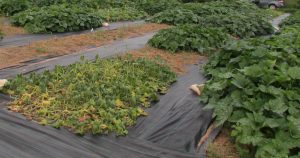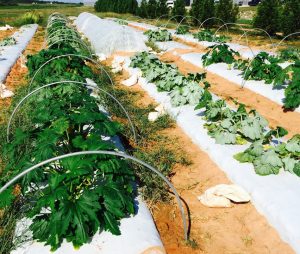
The 2017 winter squash cultivar trial at the University of Georgia showed the difference in disease resistance between a susceptible variety and the highly resistant Cucurbita moschata varieties.
By Elizabeth Little
Organic vegetable production has been steadily increasing in Georgia. Growers offer a wide variety of high-quality produce, especially during the cooler months from October to June. However, summer production can be challenging due to the proliferation of pests and diseases on non-adapted crops.
Both summer and winter squash can be plagued by many pests and diseases, and plants often die early. For summer squash (Cucurbita pepo), problems include squash vine borers, squash bugs, downy mildew and cucurbit yellow vine disease (CYVD). CYVD is a bacterial disease transmitted by squash bugs that can quickly kill plants as they start to fruit. Losses can approach 100 percent in individual plantings, depending on squash bug numbers. Downy mildew arrives in Georgia in late June or July, and may not be a problem in summer squash in a dry year.
As summer progresses, viruses and additional pests become abundant. Early planting in April or May avoids many of these problems, including early infections by downy mildew and viruses. However, summer squash is popular with consumers, and organic market growers would prefer a constant supply through the summer.
TRAP CROPS AND ROW COVERS
In organic vegetable systems, there are few silver bullets for managing pests and diseases, and multiple approaches are needed to reduce problems to acceptable levels. Squash bug management is one of these challenges. Not only do squash bugs carry CYVD, but their feeding will cause plants to decline. Squash bugs tend to hide, so organic insecticides are hard to target and are not effective on adults. Planting of an early squash trap crop before the main crop will attract emerging adults in the spring and reduce in-season population increases, but only if the pests on the trap crop are eliminated before they later disperse to the main crop.
Research on CYVD management found that the use of lightweight floating row covers for the first four weeks will eliminate early pest infestations and CYVD, and delay virus infections. Covers must be sealed along the bottom edges to completely exclude squash bugs. If removed at four weeks when the plants are starting to flower, row covers do not negatively impact yields. Row covers can help to prolong the squash season into the problematic summer months.
Summer squash grows in a bush form, allowing for the easy use of row covers. Winter squash, on the other hand, produce long vines and large plants that are not easy to cover. Winter squash are seldom attacked by squash vine borers, but squash bugs, downy mildew and CYVD are common problems. Winter squash is a long-season crop. In a wet year, downy mildew can completely defoliate susceptible varieties such as butternut and acorn before maturity, which results in poor-quality fruit. In addition, the long season allows squash bugs to build up to high numbers that cause fruit damage and plant decline.

There are beneficial effects of using row covers for four weeks on summer squash in July. Plants on the left were covered; plants in the center were not.
VARIETY SELECTION
In organic production, the use of resistant and regionally adapted species and cultivars, if available, is the most reliable approach to managing diseases and pests. Most vegetable variety selection and improvement work has not focused on adaption to organic growing conditions in the Southeast. Summer squash and C. pepo winter squash varieties such as pumpkin, delicata and acorn are better adapted to cooler and drier climates. C. maxima winter squash, such as the hubbard and candy roaster types, are also highly susceptible to disease.
However, there is a species of winter squash, C. moschata, which is native to southeastern conditions and is less damaged by many of the squash pests and diseases. Ironically, the most popular C. moschata cultivar, butternut squash, has lost most natural disease resistance, possibly through early breeding in the Northeast to improve horticultural characteristics.
Cultivar trials at the University of Georgia (UGA) have shown that the less known C. moschata types such as tan cheese, Seminole and tropical pumpkin have excellent resistance to downy mildew and are less impacted by other diseases and pests. The fruit are flavorful and store well, although butternut squash tends to still be a favorite in terms of taste and texture in side-by-side comparisons.
Common Wealth Seed Growers in Virginia specializes in developing regionally adapted, open-pollinated, downy mildew-resistant cucurbit cultivars appropriate for organic production in the Southeast. The UGA trials revealed that one of Common Wealth’s new releases, South Anna — a cross between Seminole, an heirloom southeastern variety, and Waltham butternut — has the disease resistance of the Seminole and similar fruit characteristics to a butternut. This model of on-farm trialing and breeding to select the best adapted cultivars offers promise for the continued success of organic growers in the Southeast.
Elizabeth Little is an associate professor and Extension plant pathologist at the University of Georgia in Athens.
This article was featured in the August issue of VSCNews magazine. To receive future issues of VSCNews magazine, click here.
Share this Post










